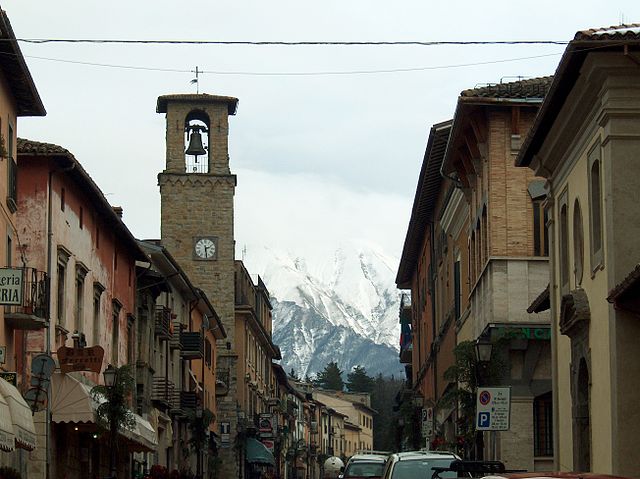The Amatriciana Dilemma Posted by Serena on Feb 17, 2015 in News
What are the true, authentic ingredients of Amatriciana sauce? This was the main topic of discussion in all the Italian newspapers last week. Why? Because master chef Carlo Cracco had the cheek to tell a member of the audience on a TV program that you should add uno spicchio d’aglio in camicia (a clove of garlic in its skin) to the sauce.
Apriti cielo! (Good Heavens!) The mayor of Amatrice, the small town which gave birth to this famous spaghetti sauce, replied sternly: “Gli unici ingredienti che compongono la vera amatriciana sono guanciale, pecorino, vino bianco, pomodoro San Marzano, pepe e peperoncino” (the only ingredients from which the real amatriciana sauce is made are guanciale*, pecorino cheese, white wine, plum tomatoes, pepper and chilly).
 |
| A view of Amatrice. Photo: Public Domain |
So, how would one go about making authentic spaghetti all’Amatriciana? After a long search on the internet, which produced many different variations, I decided to have a look on the official Amatrice web site, in order to avoid writing any heresies:
| Ingredienti per 4 persone: | Ingredients for 4 people: |
| 400 gr di spaghetti | 400 grams of spaghetti |
| 125 gr di guanciale | 125 grams of guanciale |
| 1 cucchiaio di olio d’oliva extravergine | 1 spoonful of extra virgin olive oil |
| 1 cucchiaio di vino bianco secco | 1 spoonful of dry white wine |
| 6-7 pomodori San Marzano o 400 gr di pomodori pelati | 6-7 fresh plum tomatoes or 1 tin (400 grams) of peeled plum tomatoes |
| 1 pezzetto di peperoncino | 1 small chili |
| pepe macinato fresco | freshly ground pepper |
| 100 gr di pecorino grattugiato | 100 grams of pecorino cheese, grated |
| sale | salt |
Preparation:
If you are using fresh plum tomatoes, peel them, remove the seeds, and chop them. If you are using tinned plum tomatoes, drain them, remove the seeds and chop them.
Remove the hard rind from the guanciale, and then cut it in strips about 1 cm wide. Put the oil in an frying pan, preferably made out of iron, add the guanciale and let it brown. Pour the wine in to the frying pan and let it evaporate. Add the chili, the prepared tomatoes, salt and pepper (remember that the guanciale is already quite salty).
In the meantime cook the spaghetti al dente.
When the pasta is cooked, drain it and the add it to the sauce in the frying pan, stir well, turn the heat off, add half of the pecorino cheese, and stir again. Serve hot with more pecorino cheese sprinkled on the top.
Notes:
*guanciale is a sort of bacon obtained from la guancia (the cheek) of the pig, not to be confused with the more commonly available pancetta, which is obtained from la pancia (the belly) of the pig. Il guanciale has a much stronger flavour than the pancetta.
Amatrice is a small town in the Lazio region, on the border with Abruzzi.
The sauce was originally made without tomatoes and was called ‘Grigia’ (Grey). In fact tomatoes only became incorporated in Italian cuisine during the 18th century.
The Amatriciana sauce was a staple part of the diet of shepherds, who, during their transumanza (seasonal migration with the livestock), introduced it to other parts of Lazio and Abruzzi, and in particular Rome.
The traditional pasta used with the Amatriciana sauce is spaghetti. In Rome, however, i bucatini (literally: the holed), a sort of spaghetti with a wider diameter and a hole through the centre, are very popular.
Buon Appetito!

Build vocabulary, practice pronunciation, and more with Transparent Language Online. Available anytime, anywhere, on any device.




Comments:
Phil:
Serena,
You may wish to change “chilly” to either “chili” or “chiles” or “chillies.” Chilly means cold whereas the others are various spellings (both singular and plural) for a variety of peppers (http://www.merriam-webster.com/dictionary/chili). 🙂
Phil
Anna:
I don’t see chili in the list of ingredients, however it’s spelled 🙂
just use as needed, to taste?
looks like a good recipe!
anna in california
Geoff:
My apologies for the misspelling of chili.
As I’m the one who checked Serena’s blog, and English is ‘supposed to be’ my lingua madre (although sometimes I’m not sure any more!) I take full responsibility … plus it is very chilly here at the moment 😉
Thanks Phil and Anna for pointing it out.
P.S. Anna, in the list of ingredients see: peperoncino (chili), and the recipe reads: ….. ‘Add the chili, the prepared tomatoes, salt and pepper’ … best to add to taste. Let us know how it turns out.
A presto, Geoff
Phil:
Ciao, Geoff,
No problem. I envy you your “problem” of living in Italy! Upon my (imminent!) retirement, I hope to spend more time in the “old country” as my grandparents used to say.
Phil
Geoff:
@Phil Bravo Phil! Da dove provengono i tuoi nonni?